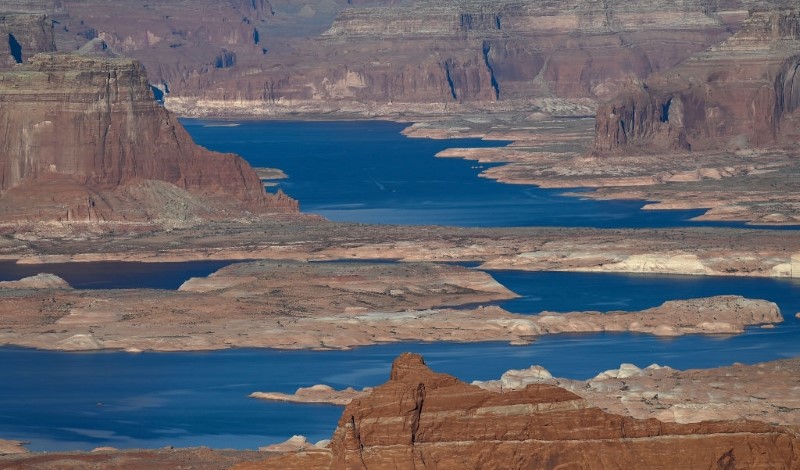
Scholar sees design flaws in federal water pollution law as fueling rival legal theories.
How can you protect something if it no longer exists? As demand for freshwater increases and supply decreases due to climate change, rivers and reservoirs are beginning to run dry across the United States.
Conventional environmental law, which includes the Clean Water Act (CWA), is insufficient to protect and preserve waterways from allocation-based and climate change threats, argues Erin Ryan, a professor at Florida State University College of Law.
In a recent article, Ryan contends that, by addressing quality alone, federal water governance fails to connect the “inextricably intertwined” elements of water quality and quantity. Ryan suggests that this gap in federal regulations over water allocation has fueled support for two legal theories—the public trust doctrine and the rights of nature movement.
From the outset, Congress expressly delineated the goals and method of the CWA—to restore the nation’s waters for drinking, swimming, and fishing by regulating water pollution and limiting previously unregulated discharges.
Ryan identifies three primary mechanisms within the CWA for targeting pollutants. First, regulators establish discharge standards for individual pollutants that limit the collective discharge of a certain pollutant by all known dischargers. Second, regulators set performance standards that dischargers must follow that are customized to reflect the toxicity of each pollutant discharged.
Finally, the CWA contains a permitting system on all pollutants released into regulated waterways from point sources, which range from factories to storm drains. One limitation of this permitting system is the lack of control over non-point sources, which include most agricultural activities, and remain in the hands of state regulators.
The CWA also encompasses the concept of cooperative environmental federalism, with federal and state regulators working together to protect water quality, and places CWA regulations firmly above any contrary state laws. In contrast, the regulation of water quantity—how much water remains within a regulated waterway—occurs almost entirely through state allocation laws independent of the CWA.
Ryan classifies state allocation laws as “the means by which state and local governments determine how much water may be removed from a waterway for agricultural, commercial, and domestic uses.” She points to these laws as the main determinant for whether enough water stays in the waterway to dilute pollutant discharges permitted by the CWA and to maintain navigational, ecological, aesthetic, and recreational functions.
Ryan contends that the heart of the disconnect between quality and quantity regulation stems from the bifurcation of water regulation into two distinct bodies of law—federal water pollution law and state allocation law. The roadblocks hindering the creation of comprehensive national standards are jurisdictional barriers, historical practice, pure practicality, and constitutional limits on federal power, notes Ryan.
The only explicit provision of the CWA that Ryan identifies as weighing in favor of water quantity is Section 404, which protects wetlands by prohibiting their elimination as standing bodies of water without permit approval.
As a result, Ryan concludes that the CWA is a “necessary but insufficient tool” for protecting threatened waterways due to the limited scope of its design. Without waterways to protect, Ryan argues, pollution control becomes meaningless.
Ryan observes that escalating water demand has paired with aridification and drought to drive rampant water scarcity. Taken together, Ryan coins this situation a “disharmonic convergence” that highlights central failures of U.S. environmental law when it comes to water regulation.
While gaping holes in federal regulatory schemes coincided with shrinking local waterways, she maintains that this landscape spurred advocates for the environment to plug the holes left by the CWA with different legal tools.
The first legal plug that Ryan dissects is the public trust doctrine. Finding its roots in Roman common law, public trust principles enshrine “the air, running water, the sea, and consequently the shores of the sea” as being common to mankind. Today, this doctrine means that states retain sovereign ownership and responsibility for managing waterways for the benefit of the public.
Beyond this managing principle, states implement this doctrine using different forms of law—from state constitutional amendments to statutory law—applied to a range of protected resources and values.
Despite its potential for preservation, Ryan warns that the doctrine’s inherent limitation lies in its inherent anthropocentrism. By explicitly protecting human interests in natural resources, the doctrine’s utilitarian calculus focuses on the benefits waterways and other resources confer on the populace.
In contrast, Ryan describes the rights of nature movement as biocentric because it protects interests in nature directly, rather than only protecting human interests. Instead of assigning rights to humans to enjoy the resource, the movement asks the law to protect the resource itself, or even give it legal personhood. Through this doctrine, a body of water in question could attain heightened legal protection that encompasses both quality and quantity restrictions.
Ryan identifies the origins of the movement in indigenous cultures worldwide, with its emergence in the Western legal tradition coming only in 1972 from an adverse ruling in a U.S. Supreme Court decision. In addition, Ryan compiles a collection of examples from the United States where tribal and local governments have enacted rights of nature rulings or laws to varying degrees of success.
Similar to the public trust doctrine, the movement contains local variation based on what receives protection and to what extent, who speaks for rights holders that cannot speak themselves, and what legal mechanisms vindicate nature’s rights.
Ryan argues that both theories display common ground in practice despite springing from different environmental ethics. Both speak to concerns “underserved” by conventional environmental law, both protect values underappreciated in cost-benefit analyses, and both embody last resort arguments in court.
Ryan concludes by reiterating the potential of these theories to be ideological laboratories of experimentation that evolve and galvanize communities outside of the courtroom. With the nation’s drying waterways, Ryan expresses hope that Congress will develop the CWA to plug the holes that these theories are being called on to fill.



